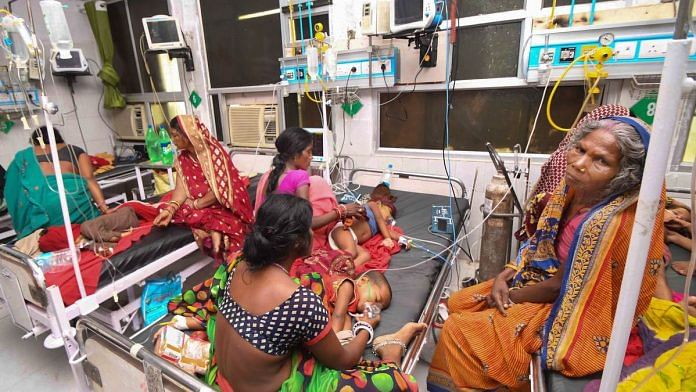Lucknow: As the death toll of children due to Acute Encephalitis Syndrome (AES) in Bihar’s Muzaffarpur district shows no sign of stopping, the Yogi Adityanath government in neighbouring Uttar Pradesh claims it has achieved substantial control over such deaths.
Speaking to ThePrint, UP health minister Sidharth Nath Singh said the AES case fatality rate in the state had dipped to 8 per cent in 2018 from 16.39 per cent in 2016. Until 17 June this year, the figure stood at 4 per cent — 16 deaths out of 440 AES cases.
Similarly, only 25 cases of Japanese Encephalitis (JE) had been reported in the state until 17 June, of which one patient had died, Singh stated.
Singh said the two diseases had been a major health concern in UP for decades. “Earlier, there were no state-specific guidelines for AES. There was ignorance about the symptoms of the disease and the factors behind its spread — water quality, hygiene, etc,” he said.
“In most cases, there was a tendency to not consult a qualified practitioner at an initial stage and at later stages, the patient would be rushed to big hospitals.”
Also read: Litchis aren’t giving encephalitis to Bihar’s kids, it’s malnourishment
Drop in numbers
In the last UP assembly session, Singh had shared data from 14 districts in the Purvanchal region, which shares a border with Bihar. According to him, around 553 deaths had been reported in 2017 out of 3,817 cases. The figure fell to 187 deaths out of 2,043 cases last year, while until February 2019, around 35 cases had come to light without any deaths.
More recently, during a review meeting of the health department, CM Adityanath praised the efforts of officials for “success in controlling vector borne diseases”. These efforts had included running a state-wide campaign.
“Giving the example of BRD Medical College, Gorakhpur, he said that in the past 40 years, this health institute used to admit around 500 to 600 encephalitis patients every year, out of which 150 to 200 children used to die,” an official statement from the UP government said. “Last year, BRD Medical College had admitted 86 children with this disease and six of them had died.”
Concerted effort
The UP government claims to have achieved this reduction through a concerted effort, including a separate set of guidelines for prevention and treatment of AES, expansion of the Paediatric Intensive Care Unit (PICU) network, awareness campaigns, as well as increased coordination among at least 12 departments.
The UP government launched two major campaigns — focusing especially on the Gorakhpur and Basti divisions of Purvanchal. While one campaign was aimed at cleanliness, with cleaning drains, fixing handpumps and constructing toilets, the other was a door-to-door drive called Dastak which included a JE-vaccination drive, identification of acute malnutrition, and referring such cases to nutritional rehabilitation centres.
“UP is the first state where government-run ambulances have been linked with ETCs for transportation of AES cases… It is also the only state where the ambulance personnel have been trained on ambulatory management of AES cases. The ambulances have been equipped with essential drugs and equipment for managing AES cases during transportation,” Singh said.
Also read: Bihar’s snoozing govt, clueless doctors blame heat and litchis as encephalitis kills 110
Concerns over the claims
The claims made by the UP government on controlling JE and AES cases, however, have met with some concerns. Doctors working on this research area have alleged that the government could be hiding data.
“There are some reports that the government has attributed the cause behind some deaths to other complications that arise due to AES. This could have been done not just at the government hospital level, but at the primary health centres or PICUs,” alleged a senior health department official who spoke on the condition of anonymity.



